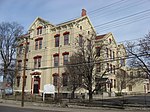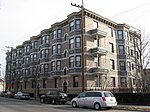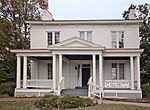Walnut Hills United Presbyterian Church
1880 establishments in OhioBell towers in the United StatesChurch ruinsChurches completed in 1880Former Presbyterian churches in the United States ... and 9 more
Gothic Revival church buildings in OhioNational Register of Historic Places in CincinnatiPresbyterian churches in CincinnatiPresbyterian churches in OhioRuins in the United StatesSamuel Hannaford and Sons Thematic ResourcesSamuel Hannaford church buildingsU.S. Route 22Walnut Hills, Cincinnati

Walnut Hills United Presbyterian Church is a historic church tower in the Walnut Hills neighborhood of Cincinnati, Ohio, United States. The last remnant of a landmark church building, it was designed by a leading Cincinnati architect and built in the 1880s. Although named a historic site a century after its construction, the building was mostly destroyed after extensive neglect caused restoration to become prohibitively expensive.
Excerpt from the Wikipedia article Walnut Hills United Presbyterian Church (License: CC BY-SA 3.0, Authors, Images).Walnut Hills United Presbyterian Church
Gilbert Avenue, Cincinnati Walnut Hills
Geographical coordinates (GPS) Address Nearby Places Show on map
Geographical coordinates (GPS)
| Latitude | Longitude |
|---|---|
| N 39.127638888889 ° | E -84.489583333333 ° |
Address
Gilbert Avenue
Gilbert Avenue
45206 Cincinnati, Walnut Hills
Ohio, United States
Open on Google Maps







